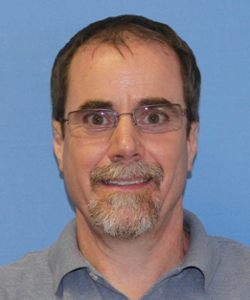
David Starkey, Ph.D.
Associate Professor, Biology Office Location: Bonilla Science Hall, Room 106 Phone: (210) 841-7249 Email: dstarkey@uiwtx.edu- B.S. Biology, Illinois State University, Normal, Ill.
- M.S. Biology, University of Illinois, Champaign, Ill.
- Ph.D. Genetics, Phylogeography of Two New World Turtle Genera, Trachemys and Kinosternon, Texas A&M University, College Station, Texas
- Assistant Professor (Tenure-Track), University of the Incarnate Word, San Antonio, Texas (2014 - Present)
- Trevino, K.N. and D.E Starkey. 2019. Stratification in Topsoil: A Preliminary Analysis of Bacterial Diversity at Two Sites in San Antonio, Texas. Texas Journal of Science, doi.org/10.32011/txjsci_71_1_Article3.
- Thesing, B.D., R.D. Noyes, D.E. Starkey, and D.B. Shepard. 2016. Pleistocene Climatic Fluctuations Explain the Disjunct Distribution and Complex Phylogeographic Structure of the Southern Red-back Salamander, Plethodon serratus. Evolutionary Ecology, 89-104.
- Day, J.L., D.E. Starkey, and J. Gerken. 2014. Prevalence of Parasitism in the Grotto Sculpin (Cottus specus), a New Species of Cave-adapted Fish from Southeastern Missouri, USA. Subterranean Biology, 12:3-14.
- Day, J.L., D.E. Starkey, G. Adams, S. Brummett, and D. Keeney. 2014. Population Genetics of Grotto Sculpin (Cottus specus), a New Cave-adapted Fish Species. Environmental Biology of Fishes, 97:1305-1315.
- Adams, G.L., B.M. Burr, J.L. Day, and D.E. Starkey. 2013. Cottus specus, a New Troglomorphic Species of Sculpin (Cottidae) from Southeastern Missouri. Zootaxa, 5:484-494.
- Land, M., A. Musto, W.R. Miller, D.E. Starkey, and J.D. Miller. 2012. Tardigrades of the University of Central Arkansas Campus. Southeastern Naturalist, 11:469-476.
- Biology 1403L Introductory Biology II Laboratory
- Biology 3361 Genetics
- Biology 3399 Human Genetics
- Biology 3442 Ecology
- Biology 4344 Evolution and Systematics
- Biology 6399 Population Genetics
Dr. Starkey's research goal is to understand how changes in biogeography can influence, or alter, gene flow leading, ultimately, to speciation. In order to understand the correlation between these processes, the lab utilizes fieldwork, molecular and analytical techniques, and patterns of distribution to infer how and/or when speciation events may have occurred. Dr. Starkey's lab will soon be investigating, in conjunction with Dr. Andy Gluesenkamp, the San Antonio Zoo, and Drs. Rick Shine and Drew Davis at the University of Texas Rio Grande Valley, the patterns of distribution in the softshell turtle, Apalone mutica. The goal of this project is to determine if the present-day patterns of distribution in this turtle reflect historical patterns i.e., does the present-day distribution of this species still suggest a single species, or do multiple species exist. Dr. Starkey's lab is also investigating the patterns of distribution in Trachemys scripta, the red eared slider, to determine if urban areas in San Antonio are serving as refugia for this species which, potentially, could be leading to allopatric speciation. His lab has also begun a project, in conjunction with the San Antonio Zoo, to investigate life history characteristics in several threatened or endangered species including the Psychedelic rock gecko (Cnemaspis psychedelica) and Henkels leaf tailed gecko (Uroplatus henkeli). The goal of these projects is to gain a baseline understanding of the growth rates of these geckos and determine the size at which reproduction begins.
Another major area of focus in Dr. Starkey's research lab is codon bias. In this ongoing study, he and his students are investigating the patterns of codon usage in two mitochondrial genes in order to determine if patterns of usage are consistent across turtle families. Their preliminary results suggest that there are differences between families which they are using to reconstruct phylogenies for these families in order to determine if they support the most widely accepted hypotheses. Overall, the research in his laboratory is focused on questions related to speciation and phylogeography. The lab is currently focusing on reptiles to address these questions. However, past projects have utilized a wide variety of taxa including bacteria, fish, and invertebrates to address phylogeographic questions.
